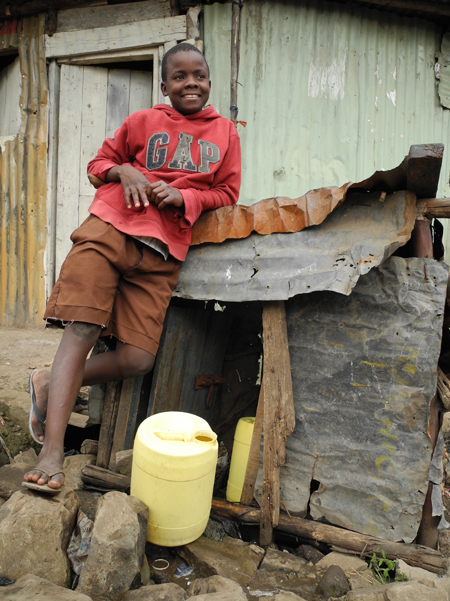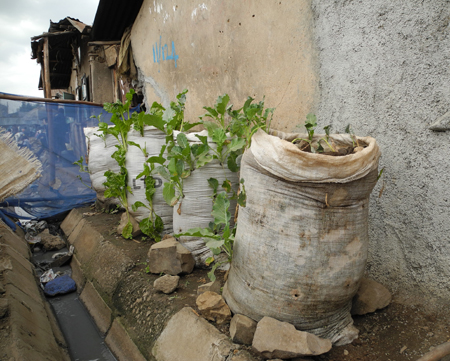This post is part of a series of reports from Global Voices’ collaboration with Map Kibera and Map Mathare that took place during the Global Voices Summit in Nairobi in July 2012.
Written, researched and photographed by Ylenia Gostoli, Saffah Faroog and Yvonne Tiany
As part of a partnership between Global Voices and the local organization Map Kibera Trust during the fifth Global Voices summit in Nairobi, Kenya, a small group of Global Voices bloggers and activists traveled to Mathare, one of the informal settlements in the outskirts of the city, to meet the citizen journalists from the Map Mathare Project. The project, originally started in Kibera in 2009, was set up in Mathare a year later. Through the dedicated work of young people from the area, it was able to create the first open street map of the slum. Informal settlements like these used to appear as blank spots on official maps; but Map Mathare also challenges commonly held views about slums as places of crime and helplessness, as the young mappers and bloggers we met work with video and write on their blog Voice of Mathare (formerly Mathare Valley Blog) about issues that affect their own community. The organization tries to balance both negative and positive stories, they tell us, and aims at changing people’s perceptions of what life in informal settlements is like, especially as both local and international mainstream media only pays attention to the slums during times of crisis and humanitarian emergency.
The bus dropped us off at the edge of Mathare, located to the north-east of the city. On one side of the busy road, five or six cobblers compete for clients next to each other. Behind them are bustling shops, fragile-looking mud and wooden constructions with tin roofs. Across the street, the road is lined with garbage that, we later learn, is dumped there by youths who collect it from local households for about 50 shillings per month. Everything here is do-it-yourself, as the government ignores the sanitation and waste problems that afflict the nearly 500,000 people who live in the settlement.
It is precisely those issues that our group, led by Yvonne Tiany, Felix Okinyi and Mike from Map Mathare, decided to investigate. “Through mapping and through blogging we try reaching a number of people: find the problems, then face stakeholders to find a solution,” says Yvonne. In one instance, she explains, floodlights were placed around an area of Mathare deemed particularly dangerous at night, especially for women, as a result of the group presenting the problem to the local district officer through their mapping.
This photo essay investigates issues of water, waste and sanitation that affect the everyday lives and health of residents. Mathare is densely populated and lacking basic water sanitation infrastructure, and a safe waste management system. Walking around the town with our local colleagues made us realize the extent to which Mathare residents take matters into their own hands to improve the quality of shared space and resources.
Clean water

Water collection point

Water is tapped illegally in Mathare
Mathare has no official water distribution system. Water trucks, which distribute clean water to residents of neighboring, wealthier areas such as Runda, Muthaiga, Umoja and Langata, do not come here, and residents rely exclusively on illegal water pipes diverted to the slum by local “entrepreneurs”. The water can be collected at water collection points like the one seen in the photograph for 1 or 2 kenyan shillings per litre. However, clean water pipes often run near the open air drains that can be found throughout the settlement. When water is not available in Mathare, members of the community are forced to move to neighboring areas to fetch it at considerably higher prices.
Waste disposal

Waste by river banks

Waste disposal sites like this one are all over Mathare
Waste management is a major issue in Mathare. Waste is often collected by organized youth groups, who charge around 50 shillings per household per month. The garbage collected is then dumped in different sites in and around the settlement. Youth from 8 to 17 may be in charge of collection in order to generate income for their families. Different groups at times may conflict over territory and catchment areas.
Playing fields

Children lack safe spaces to play in Mathare
Young children also take matters into their own hands when it comes to finding spaces where they can play in Mathare. Open spaces in the settlement are often used for dumping waste. Sometimes children take it upon themselves to clear their own playing ground, burning the garbage.
Urban gardens

Garden in a sack

Urban garden by the river banks
Urban gardens can be a good way to tackle the high price of food and vegetables, saving families an average of 100 shilling per day. However, slums are densely populated areas and it can be quite difficult to find spaces to cultivate. The picture above shows an urban garden by the river banks, just opposite a large garbage dump. The water used to irrigate the garden comes from the polluted river below, which also collects water from the open-air sewer running through the settlement. That is why some residents have started growing vegetables right on their front door. Figure 2 shows kale grown in a “garden in a sack”.
Mapping to improve facilities

The busy market in Mathare
Map Mathare has been mapping the settlement in order to show officials tangible proof of the lack of facilities in some areas, and push for action to be taken. A public toilet was built by the community, facilitated by the district officer, after Map Mathare citizen journalists showed that the busy market area lacked sanitary facilities.
All Map Mathare volunteers are young people from the community: currently, the team is made up of eight youth, from twenty to thirty years old, two of them women. Map Mathare organises community meetings where mappers ask residents what the issues that concern them are, so that they can go out and investigate them. Engaging the community in the work that they do remains the most important goal and the greatest challenge faced by Map Mathare. But the dedication of these young people to improve life in their community inspires and humbles.




3 comments
how can you heppy youths of mathare to know they right .